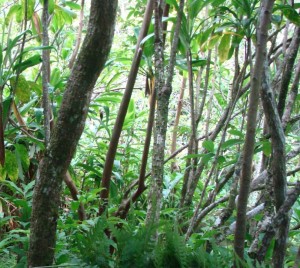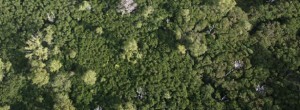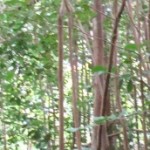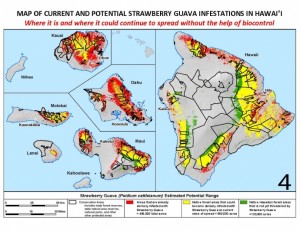Biocontrol to Begin Against Strawberry Guava
By Wendy Osher
A final environmental assessment (EA) was released today for the planned introduction of a small scale insect to control the spread of the invasive strawberry guava plant in Hawaii’s native forests.
Strawberry guava is a non-native plant that is to blame for overtaking hundreds of thousands of acres in Hawai`i since its introduction in 1825.
“I see every day, I am in the field doing work in the mountains of Lana‘i, Moloka‘i, or Maui the tremendously urgent need for biocontrol of strawberry guava,” said state wildlife biologists Dr. Fern P. Duvall.
“I am certain it is one of the very worst of habitat altering, invasive weeds to ever get a foothold in Hawai‘i,” he said.
The Tectococcus ovatus (T. ovatus) or small scale insect would provide natural control of the strawberry guava, according to the US Forest Service. The agency has determined that it will not harm any other native or beneficial plants or insects if introduced in the state.
The determination was made after more than 15 years of tests by the agency to find a natural control insect for he strawberry guava plant.
Even with the release of the biological control insect, strawberry guava will still be able to grow; but will be naturally controlled and will be less invasive to the forest, according to the report.

Strawberry guava trees grow amid ti leaf, native ginger and palapalai fern in 'Iao Valley. Many conservationists and wildlife experts have expressed concern over the plant's ability to choke out other native species. Photo by Wendy Osher.
“The National Park Service and other land managers in Hawai‘i need more tools to prevent strawberry guava from invading and displacing native forests,” said Program Manager for Vegetation Steve Anderson, Haleakala National Park.
Anderson argues that mechanical and chemical control has not been enough to keep up with the invasion of the strawberry guava plant.
“Considerable effort in mechanical and chemical control has been expended by Hawai‘i land managers over the last 20 plus years and still the invasion footprint and native species displacing monoculture formations of strawberry guava are increasing,” said Anderson.
Officials from the state Department of Agriculture agree, saying this action “needs to be taken.”
“The native forests cannot protect itself from invasive strawberry guava, and while most people are not able to see how bad it is, survey maps show the massive damage the forests have already suffered due to this invasive plant,” said Russell S. Kokubun, Chairperson of the Hawai`i Department of Agriculture.
“Saving the native forest ecosystem is far more important in terms of protecting unique resources for future generations,” Kokubun added.

Strawberry guava (dark green) amid 'ohi'a (light green/gray) in Wao Kele o Puna. Image courtesy DEA, Hawaii Office of Environmental Quality Control.
The idea of introducing a biocontrol insect was first proposed in 2005 by the US Forest Service. At that time, however, opposition from individuals and some pig hunters delayed the project.
More outreach has since been done to try to communicate the seriousness of the threat.
The Final EA indicates that there is a finding of no significant adverse impact. After at least 30 days from today’s publication, the HDOA plans to do an initial release at one site on Hawai`i Island, where the US Forest Service plan to monitor progress.
“We hope that people understand that release of this biological control insect will not kill all strawberry guava,” said Tracy Johnson, lead researcher for the US Forest Service in Hilo. “Slowing its reproduction and invasiveness, she said, “will help restore the balance in favor of the native forest plants like `ohia.”
The report also notes that the species has adversely affected Hawaii’s watersheds.
According to a University of Hawai`i study, strawberry-guava-infested forests lose 27% more water than native `ohia forests.

Strawberry guava trees grow amid ti leaf, native ginger and palapalai fern in 'Iao Valley. Many conservationists and wildlife experts have expressed concern over the plant's ability to choke out other native species. Photo by Wendy Osher.
Since its introduction to the islands more than 180 years ago, strawberry guava has grown to become a dominant species within roughly 2,000 to 5,000 acres of West Maui’s Forest Reserve and adjacent conservation lands.
“Currently strawberry guava is abundant in many places in West Maui up to 2,000 feet elevation, has strong satellite populations up to 3000 feet and is know to exist over 4,000 feet in elevation,” said Christopher Brosius, West Maui Mountains Watershed Partnership Coordinator.
“The summit of the West Maui Mountains at Pu‘u Kukui stands at 5,788 feet and strawberry guava has been known to grow in elevations in excess of that on other islands,” said Brosius.
“Given enough time and left unchecked it seems entirely possible that strawberry guava could consume vast expanses of the watershed. It seems further evident in my experience that this is also true statewide,” said Brosius.
The USDA also reports that the millions of pounds of dropped fruit are a primary source of oriental fruit flies which invade Hawai`i agriculture crops and cost Hawai`i millions of dollars annually in quarantine treatment and control efforts.
T. ovatus is a tiny scale insect that is native to Brazil. The insect lives most of its life inside leaves, causing leaf galls or bumps, which reduces the vigor of the plant, but does not kill it.
Hawai’i researchers have used biological control of plant pests and diseases in the past. Since 1975, 51 biocontrol species have been introduced to Hawai`i against a number of species including clidemia (Koster’s curse), banana poka, ivy gourd, panini cactus.
Biological control was also used more recently to save the native wiliwili trees from the erythrina gall wasp and to control the stinging nettle caterpillar.
*** Supporting information courtesy Hawaii State Department of Agriculture.











